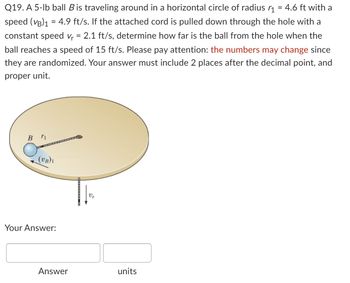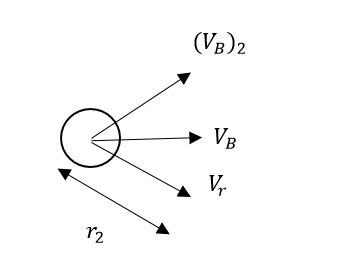
Concept explainers

To find-:
The final distance of ball from the hole.
Given-:
The weight of the ball is .
The initial radius of rotation of ball is .
The initial speed of the ball is .
The speed of the chord with which it is being pulled is .
The final speed of the ball is .
FBD-:

Calculations-:
At given final position, the net velocity of the ball is the resultant of final tangential velocity of ball and velocity of cord i.e-:
(1)
Substitute the value of and in equation (1).
Since, there is no external torque, hence angular momentum will remains conserved. So, initial angular momentum is equal to final angular momentum.
Here, is the mass of the ball and is the final distance of ball from the hole.
(2)
Substitute the value of , and in equation (2).
Thus, the final distance of ball from the hole is .
Step by stepSolved in 2 steps with 1 images

- Required information NOTE: This is a multi-part question. Once an answer is submitted, you will be unable to return to this part. Packages are thrown down an incline at A with a velocity of 2.5 m/s. The packages slide along the surface ABC to a conveyor belt which moves with a velocity of 2 m/s. The distance d= 7.5 m and μk = 0.25 between the packages and all surfaces. 2 m/s 7 m B 30° JAM'S Determine the speed of the package at C. (You must provide an answer before moving to the next part.) m/s. The speed of the package at Cisarrow_forwardQ12. A 2.9-kg collar travels down a smooth slope as shown. The spring has unstretched length of 8 m and spring constant k = 34 N/m, and it is always horizontal. If at sį = 13 m the collar has speed of 11 m/s, determine its speed when it gets to s2 = 7 m. Please pay attention: the numbers may change since they are randomized. Negative sign must be included if the work done is negative. Your answer must include 2 places after the decimal point, and proper SI unit. Take 9.81 m/s2. 3 1 アミ y S2 Your Answer: Answer unitsarrow_forwardQ23. As shown in the image below, the force acting on the 5-kg crate is a function of time. The coefficient of kinetic friction between the crate and the surface is uk= 0.14. Determine the crate's speed at t= 2.1 s if its initial speed v1 = 2.9 m/s. Please pay attention: the numbers may change since they are randomized. Your answer must include 2 places after the decimal point, and proper Sl unit. Take g = 9.81 m/s2. F = (201² +30)N (t in second) F. 30 V1 Your Answer: Answer unitsarrow_forward
- Question 2: For a 1-kg ball being pushed by a rod in the vertical path with equation r = 0.50, where is in radian and r is in meter. At the instant shown, if it has = 2 rad/s and = 4 rad/s², determine its acceleration. (a) 1.14 m/s² (b) 7.05 m/s² (c) 7.14 m/s²2 (d) 7.23 m/s² r II π 2arrow_forwardQ15. As shown in the image below, the 17-kg crate is being hoisted by the motor. If at this instant shown the velocity of point P on the cable is vp = 2.6 m/s and the speed is increasing at 1.3 m/s², what is the power input supplied to the motor if its efficiency is e = 0.63? Please pay attention: the numbers may change since they are randomized. Your answer must include 1 place after the decimal point, and proper Sl unit. Take g = 9.81 m/s². Vp Your Answer: P Answer D A unitsarrow_forwardplease solve for part Barrow_forward
 Elements Of ElectromagneticsMechanical EngineeringISBN:9780190698614Author:Sadiku, Matthew N. O.Publisher:Oxford University Press
Elements Of ElectromagneticsMechanical EngineeringISBN:9780190698614Author:Sadiku, Matthew N. O.Publisher:Oxford University Press Mechanics of Materials (10th Edition)Mechanical EngineeringISBN:9780134319650Author:Russell C. HibbelerPublisher:PEARSON
Mechanics of Materials (10th Edition)Mechanical EngineeringISBN:9780134319650Author:Russell C. HibbelerPublisher:PEARSON Thermodynamics: An Engineering ApproachMechanical EngineeringISBN:9781259822674Author:Yunus A. Cengel Dr., Michael A. BolesPublisher:McGraw-Hill Education
Thermodynamics: An Engineering ApproachMechanical EngineeringISBN:9781259822674Author:Yunus A. Cengel Dr., Michael A. BolesPublisher:McGraw-Hill Education Control Systems EngineeringMechanical EngineeringISBN:9781118170519Author:Norman S. NisePublisher:WILEY
Control Systems EngineeringMechanical EngineeringISBN:9781118170519Author:Norman S. NisePublisher:WILEY Mechanics of Materials (MindTap Course List)Mechanical EngineeringISBN:9781337093347Author:Barry J. Goodno, James M. GerePublisher:Cengage Learning
Mechanics of Materials (MindTap Course List)Mechanical EngineeringISBN:9781337093347Author:Barry J. Goodno, James M. GerePublisher:Cengage Learning Engineering Mechanics: StaticsMechanical EngineeringISBN:9781118807330Author:James L. Meriam, L. G. Kraige, J. N. BoltonPublisher:WILEY
Engineering Mechanics: StaticsMechanical EngineeringISBN:9781118807330Author:James L. Meriam, L. G. Kraige, J. N. BoltonPublisher:WILEY





